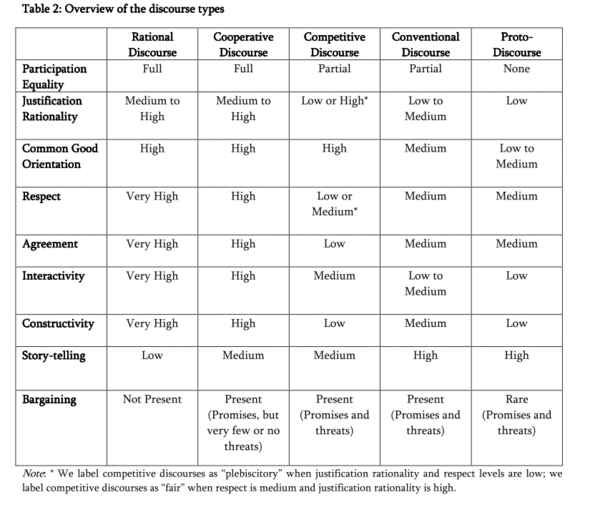Bachtiger - 2009 - Discourse Quality Index
From Deliberative Democracy Institiute Wiki
An attmept to improve DQI[1]
- Type I deliberation
- Equality - measured by precentage of participation and number of words for each participent (mean?)
- Rational Justification:
- no justification
- inferior justification where the linkage between reasons and conclusion is tenuous.
- qualified justification where a linkage between reasons and conclusion is made.
- sophisticated justification (broad) where at least two complete justifications are given.
- sophisticated justification (in depth) when at least one justification is explored in-depth, i.e., a problem is examined in a quasi-scientific way from various viewpoints.
- Common Good Orientation: The importance of referring to the common good is mainly stressed by deliberative theorists drawing on Rawls.
- whether arguments are cast in terms of narrow group or constituency interests.
- whether there is neutral reference or mixed reference (i.e., reference to both narrow group interest and common good).
- whether there is a reference to the common good. With regard to the common good, we focus both on the common good stated in utilitarian terms, i.e. as the best solution for the greatest number of people
- the common good expressed through the difference principle, i.e. the common good is served when the least advantaged in a society are helped (Rawls 1971).
- Respect Toward Demands and Counterarguments
- speakers degrade.
- treat neutrally.
- value.
- agree
- Interactivity: whether participants refer to other participants and to other participants’ arguments.
- Cunstructive Politics: This indicator is based upon the principal goal of type I deliberation to reach consensus.
- positional politics form the lowest level.
- alternative proposals, i.e. proposals that attempt to mediate but that do not fit the current agenda.
- consensus appeals.
- mediating proposals.
- Trthfulness: There is no way to mesure it by direct obsevations.
- Type II Deliberation:
- Story Telling: “story-telling” is the most important component of alternative forms of communication. They demonstrate that “story-telling” can play a central role in deliberative processes: “we find that narrative’s conventional openness to interpretation – in essence, its ambiguity – proved a surprising deliberative resource for people with marginalized points of view.”[2]. They use "sourcing" acording to Stormer-Galley[3]
- Deliberative Negoatiations:
- deliberative negoatiations: using only arguments.
- non-deliberative negoatiations: using threts or implicit threts.count whether a speech contains threats or promises[4].
Diffrent methods of deliberation should have differnt expectd values in the fifferent parts.

From Bechtiger 2009[5]
Holtinger (In German)[6]
Stromer-Galley: read[7]
References
- ↑ Bachtiger, A., et al. "Measuring deliberation 2.0: standards, discourse types, and sequenzialization." ECPR General Conference, Potsdam. 2009.
- ↑ Polletta, F., & Lee, J. (2006). Is telling stories good for democracy? Rhetoric in public deliberation after 9/11. American Sociological Review, 71(5), 699–721. p.710
- ↑ Stromer-Galley, J. (2007). Measuring deliberation’s content: A coding scheme. Journal of Public Deliberation, 3(1), 12.
- ↑ Holzinger, K. (2001). Kommunikationsmodi und Handlungstypen in den Internationalen Beziehungen. Anmerkungen zu einigen irref{ü}hrenden Dichotomien. Zeitschrift F{ü}r Internationale Beziehungen, 243–286.
- ↑ Bachtiger, A., Shikano, S., Pedrini, S., & Ryser, M. (2009). Measuring deliberation 2.0: standards, discourse types, and sequenzialization. In ECPR General Conference, Potsdam (pp. 5–12).
- ↑ Holzinger, Katharina. 2001. Kommunikationsmodi und Handlungstypen in den Internationalen Beziehungen. Anmerkungen zu einigen irreführenden Dichotomien. Politische Vierteljahreschrift 42, 414-446
- ↑ Stromer-Galley, J. (2007). Measuring deliberation’s content: A coding scheme. Journal of Public Deliberation, 3(1), 12.